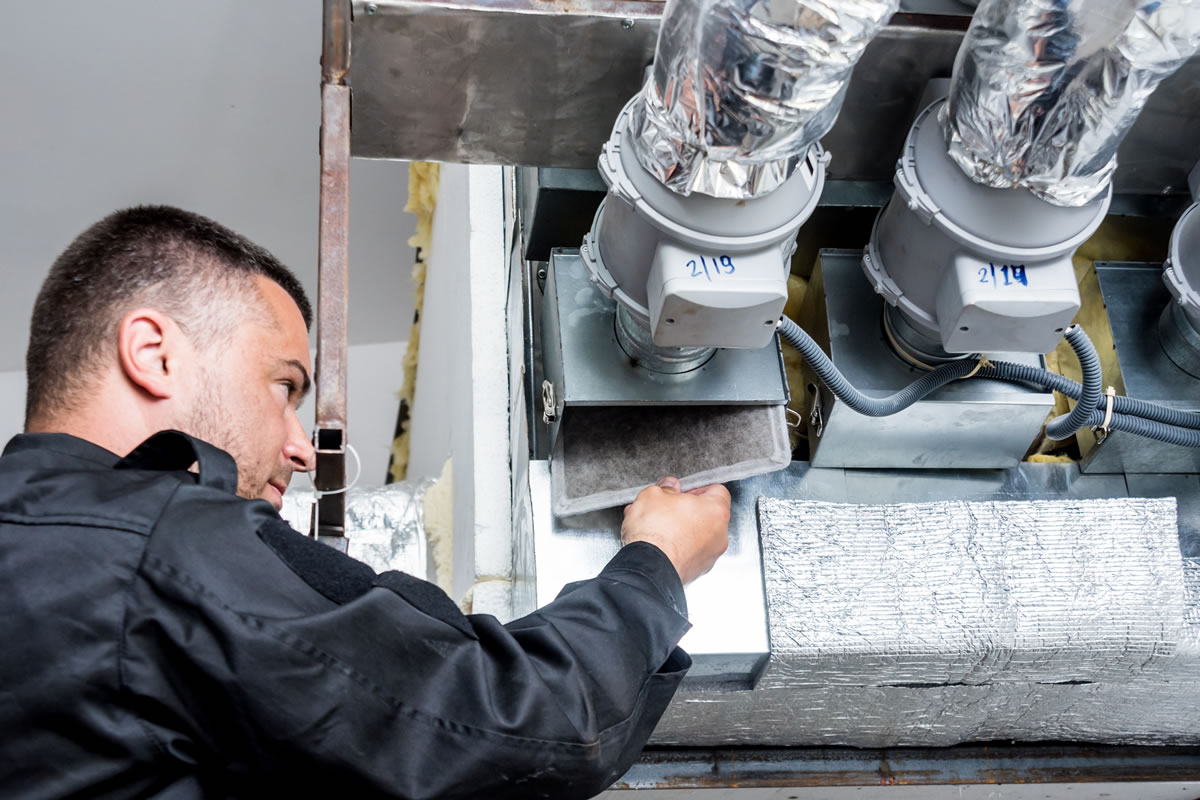What is Indoor Air Quality or IAQ?
 Indoor Air Quality (IAQ) refers to the quality of air inside buildings, impacting occupants’ health, comfort, and well-being. It is influenced by pollutants including chemicals, particulates, and biological agents including Legionella bacteria; ventilation, humidity, and temperature. Poor air quality can cause respiratory issues, allergies, and other health problems.
Indoor Air Quality (IAQ) refers to the quality of air inside buildings, impacting occupants’ health, comfort, and well-being. It is influenced by pollutants including chemicals, particulates, and biological agents including Legionella bacteria; ventilation, humidity, and temperature. Poor air quality can cause respiratory issues, allergies, and other health problems.
Good IAQ can ensure health, comfort, and productivity in indoor environments to enhance overall well-being and indoor living conditions.
A version of this story about the importance of indoor air quality first appeared in Legionella Control International’s newsletter. To get it in your inbox, sign up here.
How does poor indoor air quality affect our health?
IAQ may not be a familiar abbreviation, but you no doubt know a bit about air quality. You might then realise that IAQ stands for indoor air quality. This simply refers to the quality of the air inside a building. This covers all buildings, from hospitals to offices and factories to other facilities and businesses – and even our homes.
When we think about air quality, we tend to think about the outdoors. If you live in a city and you go on holiday to somewhere like the Welsh mountains or Scottish Highlands, for example, you’ll certainly notice the change in the air. It feels fresher, cleaner, and altogether nicer to breathe in.
Yet few of us think about the air quality in the buildings we visit each day. If you visit a workplace each day, rather than working from home, you’re going to be there for several hours each day. If the air quality in that building is not of a good enough standard, it could affect the way you feel – and it could affect your health.

How important is indoor air quality?
We have already noted that air quality can affect your health, so it stands to reason that achieving good air quality is hugely important. It’s easy to forget about IAQ because you cannot see most pollutants in the air.
Modern buildings tend to be constructed according to the latest energy efficient standards. However, in achieving this, a building can become sealed to the outside. This prevents loss of heat during the winter, but it also prevents airborne pollutants generated inside the building from escaping outside. There is little chance for any fresh air to get inside the building to dilute any pollutants that might be present, nor for it to help remove them. It’s easy to focus too heavily on energy efficiency without considering the air quality it can potentially leave you with in that space.
Why is indoor air pollution hazardous?
If you go into a building with poor indoor air quality, you may not immediately notice. However, if you spend some time there, you may begin to develop symptoms akin to those of a cold. If you suffer from asthma or another respiratory condition, you might experience a worsening of your usual symptoms.
Poor IAQ may also lead to long-term conditions. The World Health Organization (WHO) has noted several conditions, including lung cancer and asthma, that are linked to exposure to poor air quality. It’s natural to think these conditions may develop from poor outdoor air quality, and indeed they can if someone has prolonged exposure to it. However, as we can see here, indoor air quality is just as important to consider, and it can result in the same health conditions developing over time.
What are the symptoms of poor indoor air quality?
If you work in a building that suffers with poor air quality, you may notice you frequently get headaches. You might feel as if you are constantly coming down with a cold, as air pollutants can cause eye irritation, a dry throat, and congestion. To this end, it can be hard to pin down poor air quality, as colds and coughs will naturally spread from one person to another in an enclosed setting like a workplace. It’s more natural to assume you’ve just picked up a cold from someone, rather than wondering whether there is poor air quality inside the building.
If you notice you begin to feel better when you leave a building, this could be a good sign the air quality there is poor and affecting your health. Poor air quality can lead to many issues, including fatigue, a drop-off in productivity and even low mood and other mental health issues. Since most people spend around 90% of their day indoors, it makes sense to do everything we can to improve air quality in buildings. If you work in the same place each day, and that building has poor air quality, you can see how much it may affect you.

What are the most common pollutants in indoor air?
You may not be able to see them, but by monitoring the quality of your indoor air you might be surprised at how much there could be in the spaces around you.
Particulate matter
Particulate matter can refer to both liquids and solids. The former can occur when mist or water vapour is given off and contains elements that can damage our health. The best example is water vapour that contains Legionella bacteria, which can lead to the potentially fatal Legionnaires’ disease, a serious form of pneumonia.
Particulate matter can also involve tiny solids that can be inhaled into the lungs. These particles can come from cooking processes, combustion, heating, tobacco, and even dust. These are just a few examples, but the basics are clear – if particles are small enough to be inhaled into the human respiratory system, they can potentially cause both short- and long-term health problems.
Natural gases
One of the most familiar (and deadly) to you here would be carbon monoxide gas. Odourless and colourless, it is impossible to detect, and yet can be given off by a malfunctioning boiler. Incinerators, power plants and even smouldering BBQ’s also give off carbon monoxide.
We can also include carbon dioxide in this category. This will always be present in the air since we exhale carbon dioxide. The key here is how much of it is present – and as you may realise, levels can increase when indoor spaces are sealed and not adequately ventilated.
Mould
We can add mildew to this too, as both grow in damp environments and poorly ventilated areas that do not get much air flow. Think of a bathroom, steamed up after a bath. If it is left like this, mould and mildew have a good opportunity to begin growing. If the bathroom is well ventilated afterwards, with an extractor fan or simply by leaving the windows open for a while, the chances of mould and mildew developing will be far lower.
Volatile organic compounds
Volatile organic compounds, also known as VOCs, are gases that are given off by various products, whether solid or liquid in form. For example, basic furniture items are often made from particleboard. This can give off acetaldehyde gas. Materials used for insulation can do the same.
How to improve indoor air quality?
Fortunately, there are many ways to begin improving IAQ. Lots of methods for doing so are simple to introduce, while others are more complex. However, adopting a range of methods can vastly improve the situation – and potentially the health and productivity of those using the building.
The best starting point is to identify where the pollutants may come from. For example, which materials were used to construct the building? Are they likely to emit particles or gases? What about the furnishings in the building – does the same problem apply to those?
If the building has an HVAC system of some kind, covering heating, ventilation, and air conditioning (hence HVAC). This should be regularly maintained and cleaned to ensure it is working properly. Air filtration can help to ensure the air circulating within a building is free from as many contaminants as possible.
It is also sensible to go around the building to identify any issues that could be present. For example, is there anything that could create a water aerosol that could become contaminated with Legionella bacteria? Do the windows fit properly or are there regular drafts emitting from poorly fitted frames? This could let contaminants in from outside if the building is in a city or other busy area.
Obviously reducing contaminants is vital, as it will lead to better air quality overall. However, you can see that having an HVAC system is not sufficient to help with air quality in the building. It must work properly and be regularly checked to ensure this is the case, otherwise it may end up circulating poor quality air throughout the building.
Filtration is a crucial part of any HVAC system. As we noted earlier, modern buildings are often constructed to provide the best possible energy efficiency levels. However, this “hermetically sealed” approach may prevent heat from escaping… but it also prevents fresh air from coming in. It’s a fine balance, but one that must be achieved to have the best indoor air quality possible.

The bottom line with IAQ
Indoor air quality is closely associated with health. If you run a business, it makes good sense to focus on improving your IAQ. In doing so, you could end up improving productivity. According to IAQ Matters, poor air quality can lead to a drop in performance of 5%. It doesn’t sound like much, but it can equal fewer sick days and healthier employees – all of which are good things for them and for you.
No doubt you have heard of sick building syndrome. This is closely associated with poor air quality, so the more steps you can take to improve the air quality in your workplace, the more likely it is you will avoid this syndrome altogether.
It can be difficult to know where to begin, but we can help. Choosing professional air quality monitoring services who can offer expert advice means you can take advantage of improving the IAQ in your building or business. Having read this article, you can see how many advantages this may bring you.
World leading air and water safety specialists
The environmental safety specialists at Legionella Control International help business owners, facilities managers and those responsible for workplace safety maintain good indoor air quality and mitigate risks associated with Legionella and other waterborne pathogens to maintain regulatory compliance and keep people safe.
If you would like to speak with one of our environmental safety specialists call us today on 0330 223 36 86 or contact us here …


